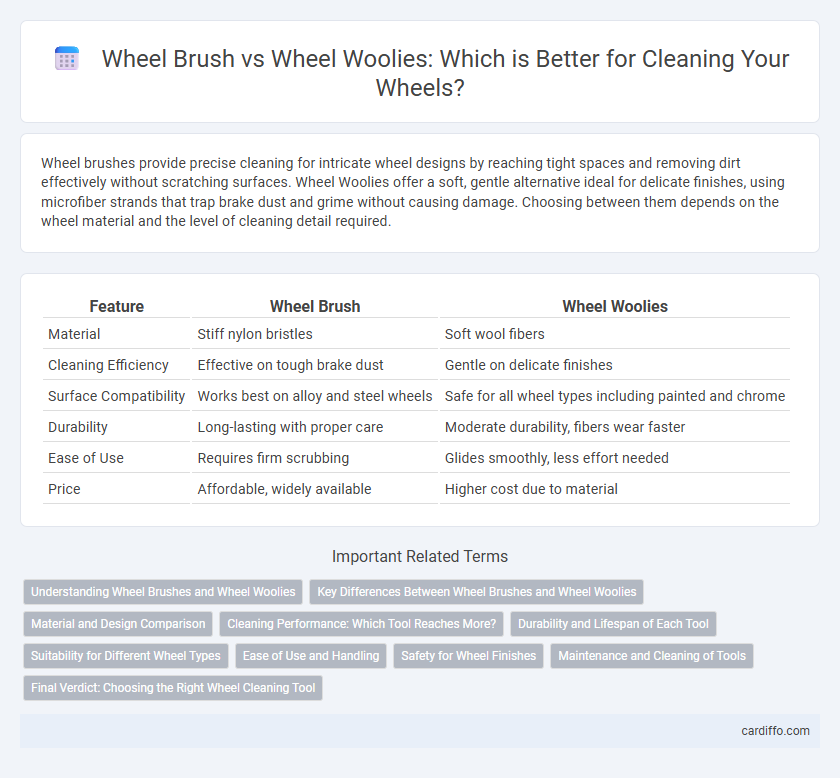Wheel brushes provide precise cleaning for intricate wheel designs by reaching tight spaces and removing dirt effectively without scratching surfaces. Wheel Woolies offer a soft, gentle alternative ideal for delicate finishes, using microfiber strands that trap brake dust and grime without causing damage. Choosing between them depends on the wheel material and the level of cleaning detail required.
Table of Comparison
| Feature | Wheel Brush | Wheel Woolies |
|---|---|---|
| Material | Stiff nylon bristles | Soft wool fibers |
| Cleaning Efficiency | Effective on tough brake dust | Gentle on delicate finishes |
| Surface Compatibility | Works best on alloy and steel wheels | Safe for all wheel types including painted and chrome |
| Durability | Long-lasting with proper care | Moderate durability, fibers wear faster |
| Ease of Use | Requires firm scrubbing | Glides smoothly, less effort needed |
| Price | Affordable, widely available | Higher cost due to material |
Understanding Wheel Brushes and Wheel Woolies
Wheel brushes are designed with sturdy synthetic bristles that effectively clean spokes, lug nuts, and rims by removing brake dust and grime from tight spaces. Wheel Woolies feature soft, absorbent microfiber strands that gently lift dirt and brake dust without scratching delicate surfaces, ideal for regular maintenance on all wheel types. Selecting between wheel brushes and wheel woolies depends on the wheel material and cleaning frequency, ensuring optimal care and protection.
Key Differences Between Wheel Brushes and Wheel Woolies
Wheel brushes feature stiff synthetic bristles designed for aggressive scrubbing to remove brake dust and grime from tight wheel crevices, while wheel woolies use soft microfiber strands for gentle cleaning and minimizing swirl marks on delicate finishes. Wheel brushes are often preferred for deep cleaning on metal or heavily soiled wheels, whereas wheel woolies excel on clear-coated or painted wheels where surface protection is crucial. The cleaning efficiency of wheel brushes depends on bristle stiffness and handle ergonomics, whereas wheel woolies rely on microfiber density and flexibility to trap dirt without abrasion.
Material and Design Comparison
Wheel Brushes typically feature stiff nylon bristles arranged in a dense, circular pattern designed for scrubbing grime from wheel surfaces and spokes. Wheel Woolies consist of soft, synthetic microfiber strands that envelop the wheel's contours, offering gentle cleaning without scratching delicate finishes. The nylon bristles of Wheel Brushes provide aggressive dirt removal, while the plush microfiber of Wheel Woolies excels at trapping brake dust and fine particles on intricate wheel designs.
Cleaning Performance: Which Tool Reaches More?
Wheel Woolies feature soft, microfibers that conform to intricate wheel designs, providing superior cleaning performance by reaching tight spaces and eliminating brake dust effectively. Wheel brushes offer stiff bristles ideal for scrubbing flat surfaces but often struggle to access deep crevices and lug nuts. For comprehensive wheel cleaning, Wheel Woolies deliver enhanced reach and thorough debris removal compared to traditional wheel brushes.
Durability and Lifespan of Each Tool
Wheel Brushes feature sturdy synthetic bristles designed to resist wear and deformation, providing a durable cleaning tool for frequent use on various wheel surfaces. Wheel Woolies, made from soft microfiber strands, offer gentler cleaning but tend to show signs of wear more quickly, especially when used on rough or heavily soiled wheels. The lifespan of Wheel Brushes generally exceeds that of Wheel Woolies, making them a more durable choice for long-term wheel maintenance.
Suitability for Different Wheel Types
Wheel brushes offer versatile cleaning on various wheel types, including alloy, steel, and chrome, due to their durable bristles that can reach tight spaces without causing damage. Wheel Woolies feature softer, wool-like fibers specifically designed for delicate finishes such as painted or clear-coated wheels, reducing the risk of scratches and swirl marks. Choosing between them depends on the wheel material and finish, ensuring effective cleaning while preserving the wheel's appearance.
Ease of Use and Handling
Wheel brushes offer versatility with ergonomic handles that provide solid grip and control for various wheel designs, facilitating efficient cleaning in tight spaces. Wheel Woolies feature a unique wool fiber construction that gently conforms to wheel contours, reducing the risk of scratches while maintaining ease of maneuverability. User preference often depends on specific wheel types and cleaning intensity, but both tools are designed to enhance ease of use and handling during detailed wheel maintenance.
Safety for Wheel Finishes
Wheel brushes offer effective dirt removal but may be abrasive on delicate wheel finishes, increasing the risk of scratches and damage. Wheel Woolies, made with softer, non-abrasive fibers, provide a safer cleaning option for sensitive finishes, preserving the protective coatings and preventing swirl marks. Choosing the right tool based on wheel material and finish type is essential to maintain the longevity and appearance of wheels.
Maintenance and Cleaning of Tools
Wheel brushes require regular rinsing and thorough drying to prevent bristle damage and bacterial buildup, ensuring longevity and effective cleaning performance. Wheel Woolies offer durable, microfiber material that resists wear and is easily washable, maintaining softness and efficiency over repeated use. Proper maintenance of both tools involves avoiding harsh chemicals and storing them in dry, ventilated areas to extend their functional lifespan.
Final Verdict: Choosing the Right Wheel Cleaning Tool
Wheel Woolies offer superior precision and softness, ideal for delicate alloy wheels and intricate designs, while Wheel Brushes deliver robust bristle strength suited for removing stubborn grime on tougher wheels. Selecting the right wheel cleaning tool depends on your wheel material and cleaning frequency; woolies excel in gentle, detailed cleaning, whereas brushes are better for aggressive dirt removal. Prioritizing wheel protection and cleaning effectiveness ensures maintenance of wheel aesthetics and longevity.
Wheel Brush vs Wheel Woolies Infographic

 cardiffo.com
cardiffo.com